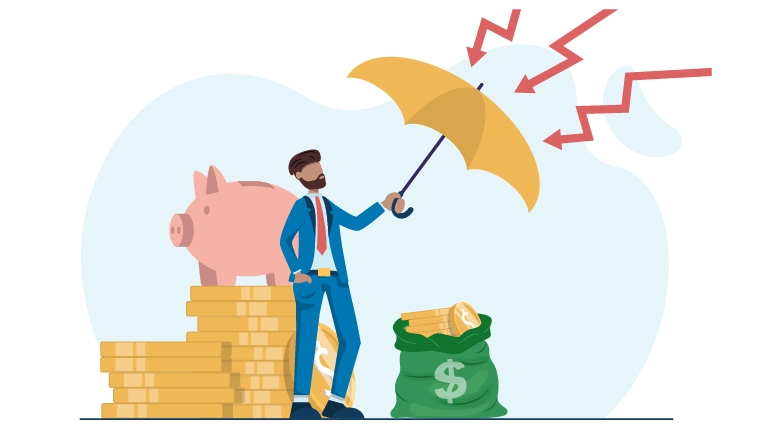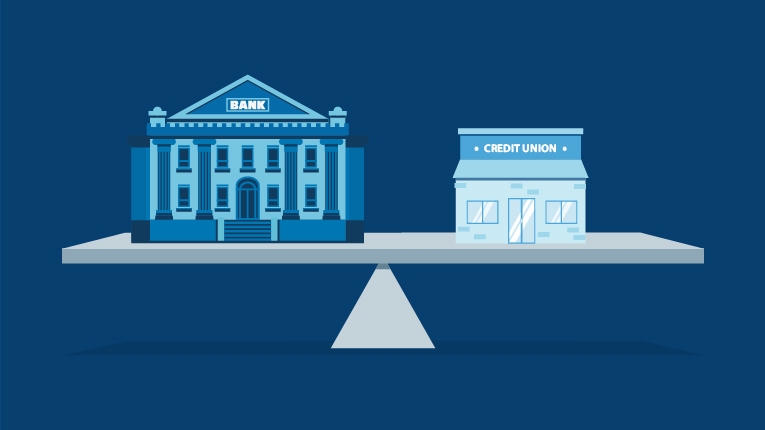Understanding Average American's Savings by Age

Having some money tucked away can provide peace of mind at any age. But how much money should you have in savings? While there’s no one answer to this question, comparing your savings to those of other people your age can give you an idea of where you stand. Learn how much money the average American has in savings and get tips for starting and growing your savings if you feel like you have some catching up to do.
How Much Do Americans Have in Savings by Age?
A savings account can prepare you for planned expenses such as vacations, unexpected expenses such as medical bills, or financial emergencies such as losing your job.Saving for retirement early on gives your money more time to grow. You may need savings for different purposes at different life stages.
According to the latest available Federal Reserve data, Americans have a median of $5,300 and an average of $41,800 in transaction accounts. (Transaction accounts are typically checking and regular savings accounts, and don’t include investments, retirement accounts, or other long-term savings that aren’t considered readily accessible.)
Average vs. median savings by age
Before you start worrying about how much is in your own savings account, let’s clarify median vs. average savings by age. Median savings is the middle data point, or the number at which half the people have more in savings and half the people have less. Average savings adds up everyone’s savings and divides the total by the number of people surveyed. So for example, nine people with $5,000 in savings and one person with $500,000 would give you an average of $54,500 in savings. As you can see, the average figure can be significantly skewed by a small number of people with much higher balances. This is why median may generally be a more accurate reflection of reality.
Below, we’ve broken out average and median amounts of savings by age group so you can see how your balance stacks up.
Savings by Age
Age | Average Account Balance | Median Account Balance |
|---|---|---|
Under 35 | $11,250 | $3,240 |
35 to 44 | $27,910 | $4,710 |
45 to 54 | $48,200 | $6,400 |
55 to 64 | $57,670 | $5,620 |
65 to 74 | $60,410 | $8,000 |
75 and older | $55,320 | $9,300 |
Source: Federal Reserve Survey of Consumer Finances, 2019.
What to Know About Savings at Any Age
How much you need to save—and how much you’re able to save—varies depending on personal factors like your income, education, family situation, lifestyle, and expenses. And while external factors such as economic instability and recessions can also influence your ability to save, generally, people within the same age group have many of the same challenges, goals, and decision opportunities when it comes to saving and spending.
Savings in your 20s
You may be starting out in your career or finishing your education—and you’re probably on a tight budget. You may face new expenses, such as paying off student loans, getting an apartment, or buying a car.
Tips for saving money in your 20s:
Create a budget.
Aim for an emergency fund covering three to six months’ worth of living expenses.
Avoid accumulating and carrying high-interest debt; pay off credit card balances in full every month.
While saving, don’t forget about retirement accounts. The earlier you begin contributing to a retirement account, such as an IRA or 401(k), the longer you’ll have to take advantage of compounding interest.
Savings in your 30s
By your 30s you may be advancing in your career and earning more money than you did in your 20s. You may be married with children, still repaying student loans, or saving for big goals like a wedding or home. While your income may be increasing, your expenses are likely growing, too—and earning more may tempt you to splurge or start living beyond your means.
Tips for saving money in your 30s:
Boost your emergency fund; you’ll need more than you did in your 20s to cover three to six months’ worth of essential living expenses.
Put tax refunds, bonuses, and other extra income into high-interest savings while also funding your retirement accounts.
Revise your budget at least annually to reflect your increasing income and expenses and any new financial goals.
Resist lifestyle creep: when you get a raise, direct some (or all) of the extra income into savings instead of spending it.
Savings in your 40s
While your income may begin to reach new highs in your 40s, your financial responsibilities may also begin to peak. You may be paying a mortgage and children’s tuition, and you may or may not still be paying your own student loans.
Tips for saving money in your 40s:
Pay off high-interest debt; charging more than you can afford to pay back on credit cards can make it harder to save as interest accrues on your balance.
Rebalance your retirement accounts annually and make sure your investment portfolio is well diversified.
Consider working with a financial advisor.
Savings In your 50s
College tuition and supporting aging parents are common expenses in your 50s. Fortunately, you may be at your peak earning power, too. You probably still have a mortgage, but your children may be more independent (or possibly out of the nest), requiring less of your time and resources.
Tips for saving money in your 50s:
Lifestyle creep can strike if your emptying nest means extra money. Revise your budget accordingly, but still focus on saving.
Boost your retirement contributions. When you turn 50, you can start making “catch-up” contributions to help grow your savings.
Increase your emergency fund. It could be more difficult to find comparable employment if you’re laid off in your 50s. Padding your emergency fund can prevent tapping retirement savings.
Research your options for a health savings account or long-term care insurance to cover healthcare costs in retirement.
Savings In your 60s
By your 60s, your children may be living their own lives and your mortgage paid off (or close to it). You might be thinking about dialing back your career, pursuing a second career, or even retiring. You have more time to yourself to consider what the future can hold. You may be thinking about downsizing your home and traveling more.
Tips for saving money in your 60s:
Review your retirement plan to make sure you’re on track.
Delay taking Social Security as long as possible to maximize your benefit.
Consider whether paying off your mortgage or downsizing into a more affordable home would make more sense for you financially.
Avoid taking on new debt.
Savings in retirement
Once you’re in retirement, your expenses generally decline, but your annual income typically drops, too. Now’s the time to make your nest egg last.
Tips for saving money in retirement:
Revise your budget for your new income and expenses.
If you haven’t already, consider downsizing to a smaller home that’s cheaper to insure and maintain.
Consider taking a low-stress, part-time job to for some extra spending money.
Look for little ways to save, such as senior discounts.
How to Start Saving Faster
Choose the right savings account to reach your savings goals faster. Some of your options may include:
High-yield savings accounts
High-yield savings accounts generally have higher annual percentage yield (APY) than standard savings accounts. You’ll often find the highest APYs at online-only banks, which tend to have low or no fees.
Pros
Higher interest rates than traditional savings account
Savings in member Federal Deposit Insurance Corporation (FDIC) banks or member National Credit Union Administration (NCUA) credit unions are generally guaranteed up to $250,000 per account, per account holder
Withdraw money any time with no early withdrawal penalty
Cons
APY may increase or decrease depending on prevailing interest rates
May require a larger initial deposit than standard savings accounts
Certificate of deposit accounts (CDs)
Certificates of deposit (CDs) are savings accounts that hold your deposit (the principal) for a certain period (the term) in return for guaranteed interest earnings. Common CD terms range from a few months to five years or more. If you hold the CD until maturity, you know exactly how much you will earn. Take money out of the CD before maturity, however, and you may face an early withdrawal penalty.
CDs can be useful for savings goals with a longer timeline, such as a vacation or wedding.
Pros
Higher APY than standard savings accounts
Guaranteed APY locked in for length of CD term
Earnings are predictable when CD is held to maturity
Accounts at member FDIC banks or member NCUA credit unions are guaranteed up to $250,000 per account, per account holder
Cons
Penalties for withdrawing money before CD maturity
Risk of being locked in a lower rate and earning less if rates continue to rise
Minimum initial deposit requirements may be $1,000 or more
Interest-bearing and rewards checking accounts
Money in a checking account generally doesn’t earn interest, however, interest-bearing checking accounts from some banks and credit unions do, though it may not be much.
To earn even more from your checking account, you might consider a rewards checking account. Like rewards credit cards, these accounts offer perks such as cash back on spending. Unlike credit cards, you’re spending money you already have, rather than running up a revolving balance. You can even find checking accounts that earn interest on your balance and rewards for your spending.
Pros
Earn interest on your checking account
Earn rewards for spending
Guaranteed up to $250,000 per account, per account holder if kept at member FDIC banks or member NCUA credit unions
Cons
Usually have higher fees than standard checking accounts, potentially canceling out earnings
May have minimum balance requirements
No matter what savings method you use, the following steps can help you grow your savings faster.
Make a budget
Budgeting helps keep your savings plan on track. Add up your monthly income and expenses and allocate a certain amount of money to each category—including savings. Track your spending for a few months and adjust your budget as needed. The 50/30/20 budgeting method is a flexible approach that devotes 20% of your income to savings (including retirement). If 20% isn’t realistic right now, that’s OK. Saving even a small amount each paycheck can eventually achieve your savings goals.
Pay down high interest debt
Carrying credit card debt gets expensive, especially when interest rates rise. Try the debt snowball or debt avalanche approach to tackle high-interest debt. Struggling to pay down debt and save money at the same time? A personal loan may be an option. A personal loan consolidates all your debt into one monthly payment at a fixed interest rate that may be more affordable than all your credit card payments combined.
Give savings a boost with extra cash
A tax refund, work bonus, inheritance, or other financial windfall can boost your savings fast. Put such “found money” into savings and watch your balance grow. Apps that let you round up your purchases to the nearest dollar or that put spare change into savings automatically can also help.
Automate your savings
Set up automated transfers from your checking to your savings account each payday or have part of your paycheck deposited directly into your savings account. You’ll be less tempted to spend money that never hits your checking account.
The Bottom Line
In the long term, saving for retirement can provide financial security in your golden years. In the short term, saving for an emergency fund, vacation, or major goal creates the confidence to handle financial setbacks without borrowing money or running up credit card bills. Reducing expenses, putting unexpected cash into savings, and selecting a savings account that maximizes your interest earnings can all build your savings faster—and achieve your financial goals sooner.
Understanding Average American’s Savings by Age FAQs
How much do Americans have in savings?
Overall, Americans have a median of $5,300 and an average of $41,800 in savings, according to the Federal Reserve. These are readily accessible savings in transaction accounts (typically checking and regular savings accounts), and don’t include investments, retirement accounts, or other long-term savings that aren’t immediately available.
How much does the average American have in savings by age?
The amount the average American has in savings ranges from $11,250 for people under 35 to $60,410 for those age 65 to 74. In general, Americans’ savings grow as they get older.
How much should a 25-year-old have in savings?
How much you’ve saved by your 25th birthday depends on your financial objectives and income. At this age, experts typically recommend putting at least 10% of your pretax income into a retirement account. You should also work to build an emergency savings account that can cover three to six months’ worth of your essential living expenses. Create a budget that includes saving for retirement, emergencies, and other goals, such as buying a home.
How much should a 30-year-old have in savings?
The amount you should have in savings by the time you’re in your 30s will vary based on your financial goals and income. However, it’s generally a good idea to have three to six months’ worth of living expenses or more stashed in an emergency high-yield savings account. On average, Americans under 35 have a median $3,240 and an average of $11,250 in savings, according to the Federal Reserve.




